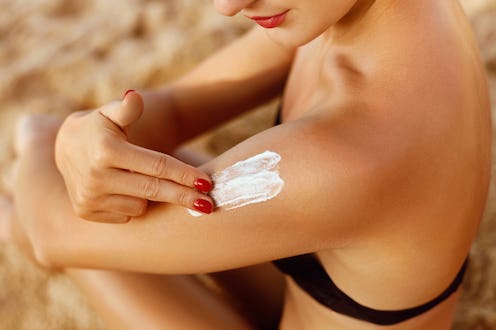Life
You're Probably Applying Your SPF Wrong, But These Simple Tips Could Change That

It's easy to think that you can't go wrong with sunscreen. After all, simply applying it is ensuring you're protected from those potentially dangerous rays, right? Well, not quite. Applying a too thin layer, missing visible skin, and forgetting to reapply throughout the day are all common mistakes. To help you avoid the pitfalls, I've put together a guide featuring five easy ways to make your sunscreen more effective.
A good sunscreen — often known as a broad spectrum sunscreen — is designed to protect against both UVA and UVB rays. The two types of ultraviolet radiation have differing effects. Exposure to UVB rays can result in sunburn, explains the Skin Cancer Foundation, while UVA can hit the skin in a deeper way, leading to premature ageing. Both rays also play a role in the development of skin cancer.
The sun protection factor (otherwise known as SPF) is a measure of how well the sunscreen can protect against UVB rays. A star rating is used for UVA protection. As the NHS states, five is the highest rating. If you see "UVA" written inside a circle on the sunscreen bottle, this signifies that the UVA protection is a minimum of one third of the SPF number and sticks to EU guidelines.
Now you know all the lingo, it's time to refresh your knowledge on best sunscreen application. Follow these tips and it's possible that you'll never burn again.
1Apply Indoors First
According to the American Academy of Dermatology, it takes around 15 minutes for sunscreen to be absorbed into the skin. That means you need to apply it before stepping outside. The NHS recommends applying 30 minutes before to ensure you're protected and a second time just before going out if you're planning to stay in the sun for a long period of time.
However, there is a catch. The above only applies to chemical sunscreens. Physical sunscreens — containing ingredients such as zinc and titanium oxide — are effective immediately, reports Well+Good. Why? "The chemical ones are those absorbers whereby UV rays enter the skin, are absorbed, and come out usually as infrared rays," dermatologist Saxon Smith told HuffPost. "The physical ones are reflectors and they do just that: they form a protective layer on the skin and reflect those UV rays."
Chemical sunscreens, however, do tend to be much easier to find and are less likely to leave a visible residue, making them most people's preferred option.
2Choose The Correct SPF
An SPF of at least 15 is needed to protect against UVB rays, states the NHS. (You should also look for a four star UVA protection rating.) However, it's common to opt for an SPF 30 sunscreen. So what's the difference?
According to the Skin Cancer Foundation, each SPF increase blocks an additional percentage of UVB rays. SPF 15 can protect against 93 percent of such rays while SPF 30 is slightly better at 97 percent. The higher you go, the less the percentage rise. SPF 50, for example, is thought to be only one percent better than SPF 30. The one thing that is definite is that no sunscreen is 100 percent effective.
There is some debate over extremely high SPF ratings. A 2017 study published by the Journal of the American Academy of Dermatology examined the difference between SPF 50+ and SPF 100+. Each sunscreen was applied on one side of 199 adults' faces. They then spent the day in the sun. Researchers found that 55 percent of participants were more sunburned on the SPF 50+ side. In fact, they concluded that people were 10 times more likely to burn on the SPF 50+ side and that SPF 100+ was "significantly more effective in protecting against sunburn."
3Reapply At The Correct Times
You've probably come to the realisation that you don't apply enough sunscreen. (Most adults should apply enough on their body to fill a shot glass, states the American Academy of Dermatology.) Or that you're missing vital spots. Typically, these areas tend to be around the eyes.
But failing to reapply at the correct time, or failing to reapply at all, will also severely reduce the efficacy of your sunscreen. Generally, it's recommended to reapply every two hours. But if you swim, sweat, or dry yourself with a towel, you'll need to reapply immediately afterwards. This, states the NHS, applies even when the bottle states it's water-resistant.
4Don't Put Skincare Products On Top
Sunscreen should be applied at the end, or pretty close to the end, of your beauty routine, dermatologist Dr. Melda Isaac explained to HuffPost. "If you are using a cream-based or lotion-based sunscreen, which most people do, you want to put that on after your moisturiser," she said, adding that mixing sunscreen with a moisturiser will dilute it.
You are of course free to put on makeup afterwards as this won't have a negative impact. Just remember to reapply the sunscreen if you choose to put some kind of skincare product on during the day.
5Make Sure It Hasn't Expired
When was the last time you checked the expiry date of your sunscreen? If you only apply it during the summer, you're likely using the same one as last year. (That stuff can be expensive, after all.) Theoretically, this should be fine as "most sunscreens are good for up to two years," dermatologist Dr. Elizabeth Hale told The Daily Beast.
But you need to think carefully about where it's been stored. "If you keep it in your car or golf bag or another sweaty, hot environment then it destabilises and the sunscreen is less effective," Hale added. If you're guilty of this, it's probably time to buy a fresh lot.
6
Oh, and one more thing: according to Vogue, you should be wearing sunscreen all year round. Now that one might take some getting used to.